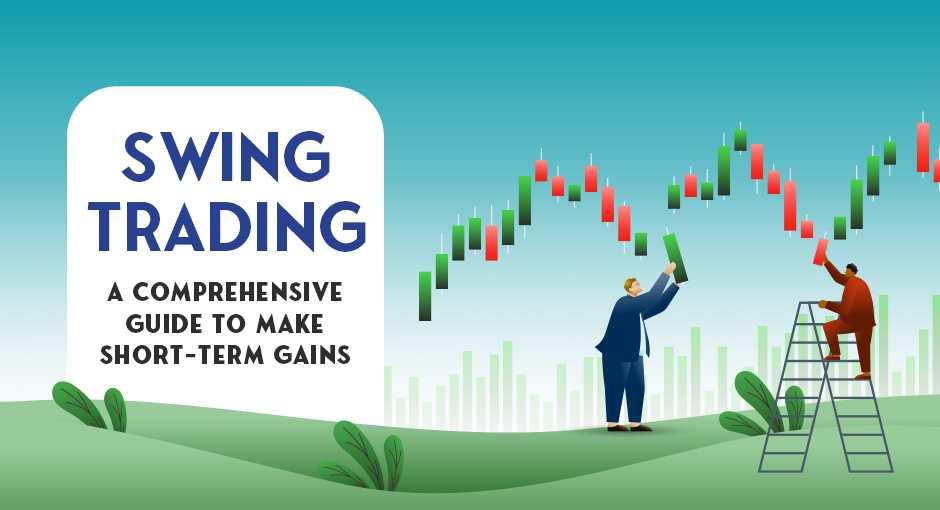
Swing Trading: A Comprehensive Guide to Make Short-Term Gains
Swing trading is a speculative trading strategy in financial markets that involves buying and selling stocks within a few days or weeks to profit from price changes or ‘swings’. Swing trading is based on the principle of buying low and selling high. Traders look for stocks that are undervalued and have the potential to increase in price in the short term. They then buy these stocks and hold them for a few days or weeks until they reach their target price. It is a popular trading style among traders who want to take advantage of short-term price movements in the market.
Thank you for reading this post, don't forget to subscribe!Definition of Swing Trading
Swing trading is a kind of trading strategy that involves holding a position either long or short for more than a trading session, but usually not longer than a few weeks or a couple of months. This is a basic time frame, as some trade decisions may extend longer than a couple of months, yet the trader may still regard them as swing trades.
Swing traders use technical analysis to identify stocks that are likely to move up or down in price over the short term. Technical analysis involves analyzing charts and other technical indicators to identify patterns and trends in stock prices. Swing traders use this information to make informed decisions about when to buy and sell stocks. Some swing traders also combine fundamental analysis for better results.
How it works
Swing traders use technical analysis to identify these stocks by analyzing charts and other technical indicators. Once a stock has been identified, the trader will buy the stock and hold it for a short period of time. The trader will then sell the stock when it reaches a predetermined price target or when the trader believes that the stock has reached its peak.
The right stocks for swing trading
The right stocks for swing trading are those that have high liquidity and volatility. The term “liquidity” describes how quickly a stock can be bought or sold without impacting its price. Volatility describes how much a stock’s price changes over time. Stocks with high liquidity and volatility are ideal for swing trading. Because they allow traders to enter and exit positions quickly and take advantage of short-term price movements.
If you’re looking for the best share broker in India to help you with swing trading, you may want to consider brokers that offer low brokerage fees, good customer service, and a user-friendly trading platform. In particular, we need the right stocks and the right brokerage platform with low fees for delivery equity.
How to Identify Support and Resistance Points for Swing Trading
Support and resistance points are key levels that traders use to identify potential entry and exit points for swing trades. Resistance levels are price levels at which a stock has historically had difficulty rising above, while support levels are price levels at which a stock has historically had difficulty falling below.
Traders employ technical analysis tools like trend lines, moving averages, and chart patterns to pinpoint levels of support and resistance. Trend lines are used to understand the direction of a stock’s price trend. Moving averages are used to identify the average price of a stock over a defined period of time. Chart patterns are used to identify patterns in a stock’s price movements. By using these tools, traders can increase their chances of making profitable trades.
In bearish markets, traders look for support levels at which a stock has historically had difficulty falling below. These levels can be used as potential entry points for long positions. In bullish markets, traders look for resistance levels at which a stock has historically had difficulty rising above. These levels can be used as potential entry points for short positions.
Swing traders also use other technical indicators such as the relative strength index (RSI) and the moving average convergence divergence (MACD). They also help to identify potential entry and exit points for trades.
Strategies for Swing Trading
There are two main strategies that swing traders use to identify stocks that are likely to move up or down in price over the short term. They are:
Technical analysis
Technical analysis is a method of analyzing stocks that involves studying charts and other technical indicators to identify patterns and trends in stock prices. These trends can be identified and used to make informed decisions about when to buy and sell stocks.
Technical analysts use a variety of tools to analyze stock prices, including moving averages, trend lines, and momentum indicators. Moving averages are used to identify the mean price of a stock over a specific period of time. Trend lines are used to determine the direction of a stock’s price trend. Momentum indicators are used to identify changes in a stock’s price momentum.
Fundamental analysis
Fundamental analysis is a method of analyzing stocks that involves studying a company’s financial statements and other economic indicators to determine its intrinsic value. Fundamental analysts believe that a company’s intrinsic value is reflected in its stock price. This value can be used to make informed decisions about when to buy and sell stocks.
Fundamental analysts use a variety of tools to analyze a company’s financial statements. It includes earnings reports, balance sheets, and cash flow statements. They also look at economic indicators such as interest rates, inflation rates, and gross domestic product (GDP) growth rates.
Risk management
Risk management is an important part of swing trading. Swing traders use risk management strategies to minimize their losses and maximize their profits. Use the common risk management strategy, like stop-loss orders. An order to sell a stock through a broker at a specific price is known as a stop-loss order. This helps traders limit their losses if the stock price falls below a certain level.
Another risk management strategy used by swing traders is diversification. Diversification involves investing in multiple stocks across different sectors of the economy. This helps traders spread their risk across different stocks and sectors, reducing the impact of any one stock or sector on their overall portfolio.
Pros and Cons of Swing Trading
Swing trading offers benefits and drawbacks, just like any other trading approach.
Advantages of swing trading
One advantage of swing trading is that it allows traders to take advantage of short-term price movements in the market. Swing traders can enter and exit positions quickly, allowing them to take advantage of short-term price movements that other traders may miss.
Another advantage of swing trading is that it allows traders to limit their risk. Because swing traders hold positions for a short period of time, they are less exposed to long-term market risks than other traders.
Disadvantages of swing trading
One disadvantage of swing trading is that it requires a lot of time and effort. Swing traders need to be able to identify stocks that are likely to move up or down in price over the short term. A lot of investigation and analysis are needed for this.
Another disadvantage of swing trading is that it can be risky. Because swing traders hold positions for a short period of time, they are more exposed to short-term market risks than other traders. This means that they need to be able to manage their risk carefully.
Conclusion
Swing trading is a strategy that uses technical analysis and fundamental analysis to identify stocks that are likely to move up or down in price over the short term. It has its advantages and disadvantages, and traders need to be able to manage their risks carefully. The main advantage of swing trading is that it can be used in different types of markets. Also, swing trading can be profitable in both increasing and decreasing trends.
Why Goodwill for Swing Trading?
Goodwill offers live training sessions for those interested in learning more about swing trading. We give free delivery equity transactions and just Rs. 11 per equity intraday, commodity, and currency transactions. Our platform is designed to make trading simple and available to all users. We provide the resources and tools you need, whether you’re a novice or a seasoned trader, to be successful.
If you’re looking for a Demat account opening service that is easy to use and reliable, consider Goodwill. We offer a simple online process that allows you to open an account quickly and easily. Our platform is designed to make it easy for you to manage your investments and trades from any place.

